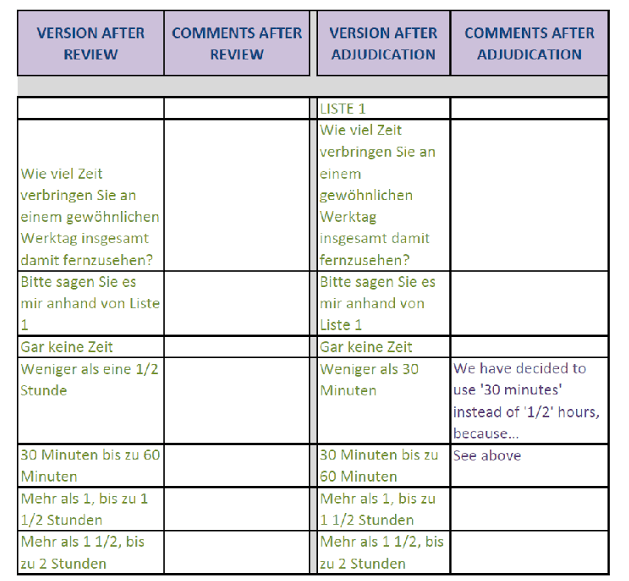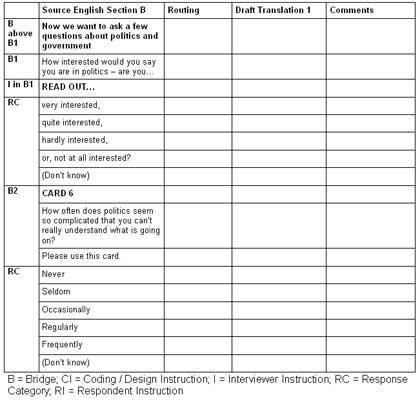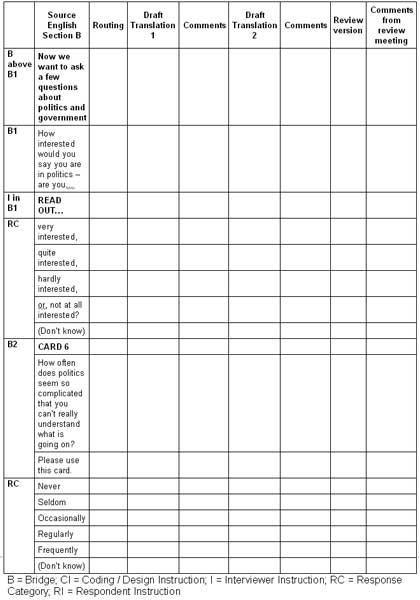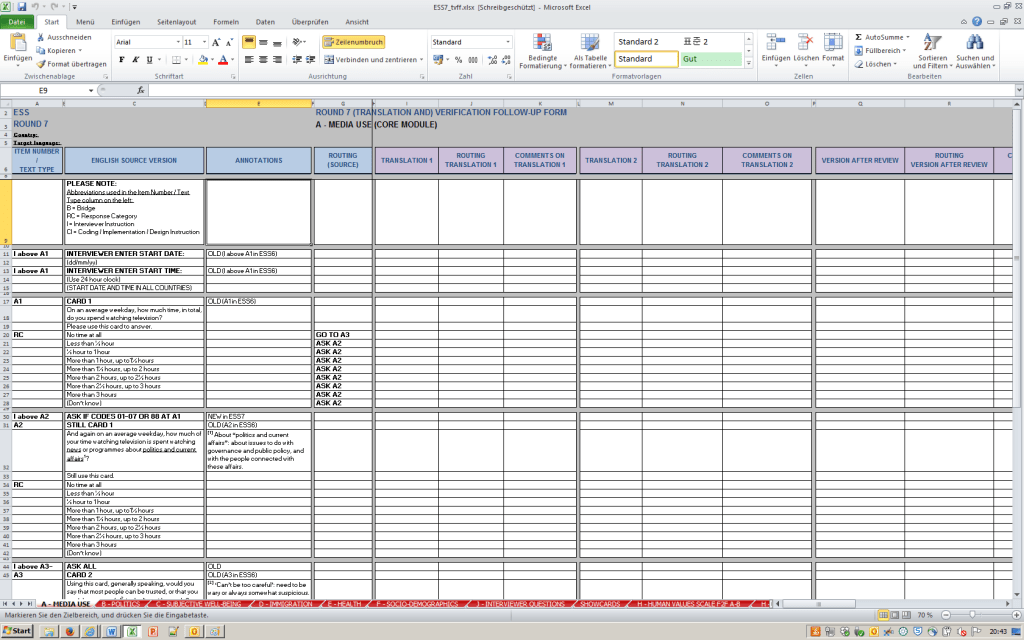- Home
- About Us
- Chapters
- Study Design and Organizational Structure
- Study Management
- Tenders, Bids, and Contracts
- Sample Design
- Questionnaire Design
- Instrument Technical Design
- Translation
- Adaptation
- Pretesting
- Interviewer Recruitment, Selection, and Training
- Data Collection
- Paradata and Other Auxiliary Data
- Data Harmonization
- Data Processing and Statistical Adjustment
- Data Dissemination
- Statistical Analysis
- Survey Quality
- Ethical Considerations
- Resources
- How to Cite
- Help


Appendix A (Translation and Documentation Templates)
Nowadays, it is recommended to make use of Excel files in order to both carry out and document the whole questionnaire translation processes and histories for each language version.
Below, the Translation and Verification Follow-up Form (TVFF), used by the ESS since Round 5, will be described and discussed as an example of such an excel-based translation and documentation template.
The TVFF as used by the ESS in Round 7 can be downloaded from the ESS website.
Development of the TVFF
The TVFF was created prior to the translation activities of Round 5 of the ESS: in ESS Rounds 1-4, Word-based translation templates had been used (see below). In Round 5, ESS used, for the first time, translation verification by the external service provider cApStAn as an additional translation quality assessment step. cApStAn had been using 'Verification Follow-up Forms' (VFFs) for their verification processes in other projects prior to verifying ESS translations. The TVFF was thus a way to combine the ESS translation templates with the verification templates; this allowed usage of only one template for the whole translation history for each language version. The TVFF is therefore the result of close collaboration between the ESS translation team (more information can be found here) and cApStAn.
[For clarification: the abbreviation sometimes uses brackets, as “(T)VFF,” and sometimes not, as “TVFF”: in the case of the ESS, the national teams have the choice to use this Excel file for their translations (“T”) too—but it is used for verification (“VFF”) in all cases; this optional use for translation is mirrored by retaining the 'T' in these guidelines.]
Overview of the TVFF
Figure 1 is an overview of the TVFF used in Round 7 of the ESS: it allows for adequate documentation of the translation process, in addition to documentation of the verification process if used as a method of assessment (see Translation: Assessment). (For a more detailed explanation of the ESS Round 7 TVFF, see the ESS Round 7 Verification Instructions 2014). Being an Excel file, the TVFF is highly flexible and can easily be tailored to different projects’ needs. Also in the ESS, it is slightly modified from round to round in order to be adapted to new methodological developed in each round.
Figure 1: Overview of the TVFF.
Figure 2 shows the first columns from Figure 1—with blue headers—in greater detail. The first four columns include (i) the item number; (ii) the English source version; (iii) the ESS annotations, such as the footnotes from the questionnaire, changes between rounds, etc.; and (iv) routing information (e.g., “GO TO”, “ASK item X”, etc.). The columns are populated prior to translation and should not be edited during translation.
Figure 2: The Source Version Area of the TVFF.

The columns in Figure 3 are for use by each target country translation team. There are four columns in which to enter the two independent initial translations and the comments relevant to each of these, two columns for the version after the review process and relevant comments after review, and an optional column for issues that arise during discussions between countries that share a language (see also Translation: Shared Language Harmonization). The last two columns are for the version that will be verified in the assessment phase (see Translation: Assessment) and for comments arising from the adjudication process.
Figure 3: Translation Area of the TVFF, reserved for the national teams.

There may be terms or expressions that are difficult to translate and that have been subject to a lot of discussion during the review and adjudication processes. In such cases, it is likely that actors carrying out later translation quality assessments will also stumble over the same issues; it would thus be helpful to document the reasoning behind the choice of word or expression in the comment column.
Figure 4 provides an example of a documented adaptation.
Figure 4: Example of a documented adaptation.

If verification by an external reviewer is a utilized method of assessment, additional columns can be added to the TVFF (see Translation: Assessment, Appendix B).
Translation templatesBefore Excel-based translation templates have started to be in use (see above), translation templates had been Word-based in larger 3MC surveys. However, as Excel templates offer more flexibility, especially in terms of adding additional columns in order to represent the whole translation history within a project; for instance, the ESS moved to the Excel-based TVFF in Round 5. Other surveys may still use Word-based templates.
Template 1 is typical of templates used in the ESS in Rounds 1-4 for the initial translations. The source questionnaire was entered in the template in distinct sections. Each translator enters their translation in the template and provides commentary. For later stages in the translation process, similar templates retain information from each foregoing stage and add columns for outcomes and comments on the current step (see Template 2).
Template 1: Extract from a translation template from the ESS Round 4 for one initial translation (still called ‘draft translation’ in earlier ESS rounds).

Template 2 illustrates possible headings for a template bringing together two initial translations for a review meeting based on Template 1.
Template 2: Headings and columns required for a team review meeting.

For more on the use of the TVFF in assessment through verification, see Translation: Assessment, Appendix B.
